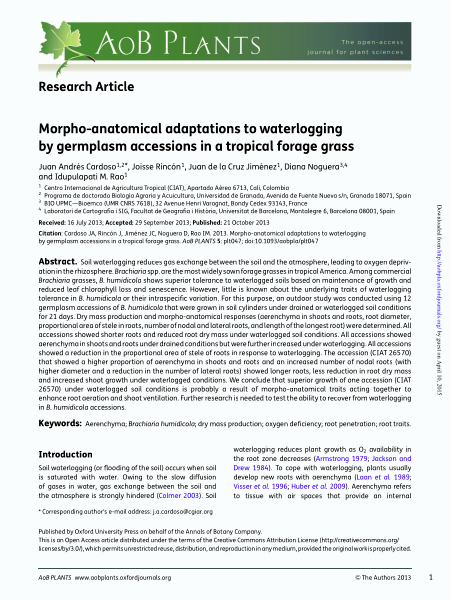Morpho-anatomical adaptations to waterlogging by germplasm accessions in a tropical forage grass
Soil waterlogging reduces gas exchange between the soil and the atmosphere, leading to oxygen deprivation in the rhizosphere. Brachiaria spp. are the most widely sown forage grasses in tropical America. Among commercial Brachiaria grasses, B. humidicola shows superior tolerance to waterlogged soils based on maintenance of growth and reduced leaf chlorophyll loss and senescence. However, little is known about the underlying traits of waterlogging tolerance in B. humidicola or their intraspecific variation. For this purpose, an outdoor study was conducted using 12 germplasm accessions of B. humidicola that were grown in soil cylinders under drained or waterlogged soil conditions for 21 days. Dry mass production and morpho-anatomical responses (aerenchyma in shoots and roots, root diameter, proportional area of stele in roots, number of nodal and lateral roots, and length of the longest root) were determined. All accessions showed shorter roots and reduced root dry mass under waterlogged soil conditions. All accessions showed aerenchyma in shoots and roots under drained conditions but were further increased under waterlogging. All accessions showed a reduction in the proportional area of stele of roots in response to waterlogging. The accession (CIAT 26570) that showed a higher proportion of aerenchyma in shoots and roots and an increased number of nodal roots (with higher diameter and a reduction in the number of lateral roots) showed longer roots, less reduction in root dry mass and increased shoot growth under waterlogged conditions. We conclude that superior growth of one accession (CIAT 26570) under waterlogged soil conditions is probably a result of morpho-anatomical traits acting together to enhance root aeration and shoot ventilation. Further research is needed to test the ability to recover from waterlogging in B. humidicola accessions.

